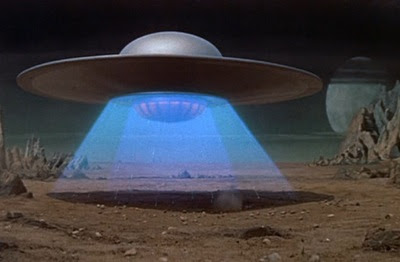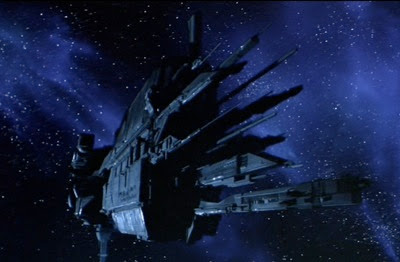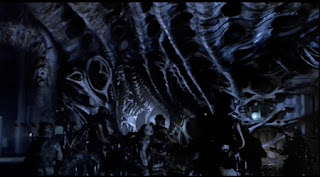As with much earlier films, Aliens is dependent on its heavy traditional science fiction visuals
 and themes. This is easily illustrated by the film’s very first image, an expanse of empty space, dominated by a large blue nebula in which can be seen a futuristic spacecraft. The film features the familiar story of heroic humans traveling into deep space to do battle with an evil and horrific alien species. Enormous space ships carry a group of adventurous soldiers to a hostile alien world, where they must contend with evil aliens. Every scene is dominated by futuristic looking technology including computers, spacecraft, buildings and weapons. However, while the film has a familiar and traditional sci-fi story, the overall tone and visual style is different that previous films of the genre. As an example, please take into consideration these two images. The first, the space ship from Forbidden Planet, the second the Sulaco from Aliens.
and themes. This is easily illustrated by the film’s very first image, an expanse of empty space, dominated by a large blue nebula in which can be seen a futuristic spacecraft. The film features the familiar story of heroic humans traveling into deep space to do battle with an evil and horrific alien species. Enormous space ships carry a group of adventurous soldiers to a hostile alien world, where they must contend with evil aliens. Every scene is dominated by futuristic looking technology including computers, spacecraft, buildings and weapons. However, while the film has a familiar and traditional sci-fi story, the overall tone and visual style is different that previous films of the genre. As an example, please take into consideration these two images. The first, the space ship from Forbidden Planet, the second the Sulaco from Aliens.

Aliens is both dark and violent, and it portrays a future far removed from the sleek, stylish films of earlier decades. Taking suspenseful cues from the previous film in the series, Alien, Aliens is dark and claustrophobic. The imagery shown during the soldier’s first encounter with
 the aliens is an example of this. The strange, confining tunnels provide a suspenseful and dark interior for one of the film’s climaxes. Aliens, released in 1986, is the third film by director James Cameron. His previous projects, Terminator (1984) and Rambo: First Blood II (1985) obviously inform both the tone and visual style of this film. Terminator, being another science fiction film, shares much in common with Aliens. Both of these early Cameron films show a possible future that is dystopic and very bloody. Both films are visually and thematically dark, and feature very high on screen body counts. Many films from this era of science fiction have a similar dark visual style and mood, 1982’s Blade Runner and the later Robocop were also products of this trend.
the aliens is an example of this. The strange, confining tunnels provide a suspenseful and dark interior for one of the film’s climaxes. Aliens, released in 1986, is the third film by director James Cameron. His previous projects, Terminator (1984) and Rambo: First Blood II (1985) obviously inform both the tone and visual style of this film. Terminator, being another science fiction film, shares much in common with Aliens. Both of these early Cameron films show a possible future that is dystopic and very bloody. Both films are visually and thematically dark, and feature very high on screen body counts. Many films from this era of science fiction have a similar dark visual style and mood, 1982’s Blade Runner and the later Robocop were also products of this trend.As these visuals show, this dark, violent tone informs the film’s mise-en-scene significantly. Visually the film is both dark and confined. Steel corridors and the strange alien tunnels are basically the film’s only settings. The story’s dependence on both these dark settings, horrifying aliens and the overwhelming use of fantastic science fiction technology are the film’s main attraction. These elements truly all come together in Ripley’s climactic battle with the alien queen at the film’s conclusion.
 Aliens is the prime example of a short lived period of science fiction films that were informed as much by the fantastic escapism of films like Star Wars, as they were by the dystopian darkness of the other films of the time. It continues the tradition set down by its suspenseful sci-fi horror hybrid predecessor, while also continuing with the violent action movie style of its director. Aliens is very much a product of its time and place in science fiction cinema.
Aliens is the prime example of a short lived period of science fiction films that were informed as much by the fantastic escapism of films like Star Wars, as they were by the dystopian darkness of the other films of the time. It continues the tradition set down by its suspenseful sci-fi horror hybrid predecessor, while also continuing with the violent action movie style of its director. Aliens is very much a product of its time and place in science fiction cinema.
